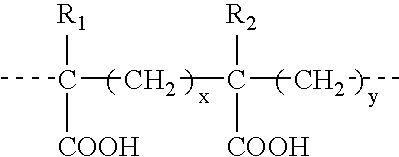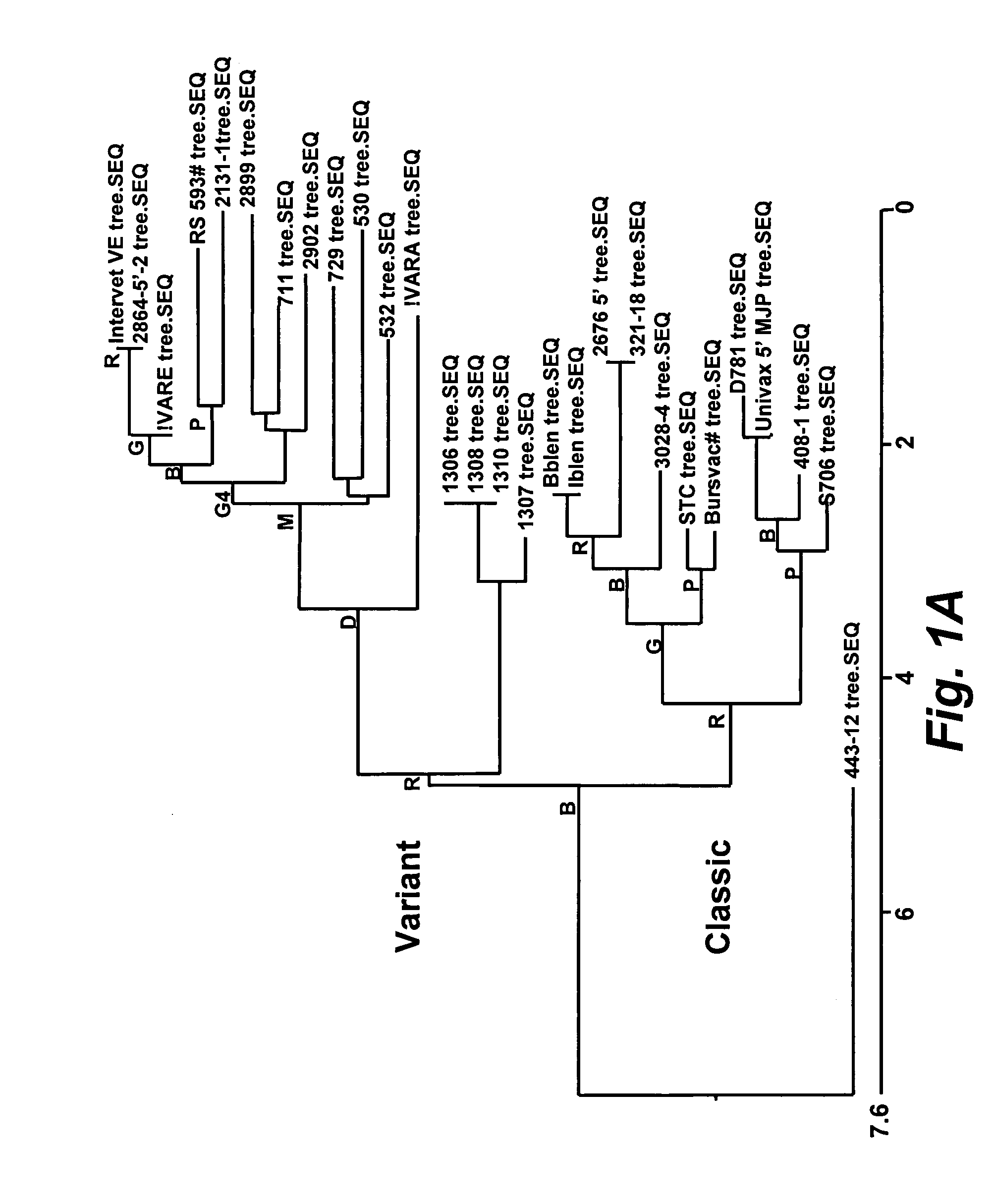Methods of characterizing infectious bursal disease virus
a bursal disease virus and infectious technology, applied in the field of infectious bursal disease virus characterization, can solve the problems of increasing the incidence of secondary infections of immunosuppressed flocks, condemning affected carcasses for contamination, and none of these noninfectious or infectious agents consistently in a majority of cases
- Summary
- Abstract
- Description
- Claims
- Application Information
AI Technical Summary
Benefits of technology
Problems solved by technology
Method used
Image
Examples
example 1
Primers for Amplifying VP2 Regions of IBDV
[0155]
B5 5′: GGTATGTGAGGCTTGGTGAC(SEQ ID NO: 7)B5 3′: TTATCTCGTTGGTTGGAATC(SEQ ID NO: 8)B4 5′: TCTTGGGTATGTGAGGCTTG(SEQ ID NO: 9)B4 3′: GGATGTGATTGGCTGGGTTA(SEQ ID NO: 10)
[0156]FIG. 1 shows a phylogenetic tree of nucleic acid sequences aligned using Clustal method with Weighted residue weight table. Sequences were determined by either the University of Georgia Molecular Genetics Instrumentation Facility (Athens, Ga.) or SeqWright DNA Technologies Services (Houston, Tex.). The MegAlign program (DNASTAR, Inc., 1228 S. Park St., Madison, Wis. 53715) was used to align and make tree and SeqEdit (DNASTAR, Inc., 1228 S. Park St., Madison, Wis. 53715) was the program used to convert the sequences to amino acids. It is apparent to one of skill in the art that the IBDV sequences of FIG. 1 encompass the majority sequence as well as the tree sequences with the nucleotide substitutions indicated therein.
example 2
Pathology of IBDV
[0157] Tissue collection—Sample Selection. Sick or acute birds were selected for specific etiologies. Routine healthy birds were selected for routine monitoring. Broilers were 14, 21, 28 or 35 days of age. Pullets are 21, 28, 35, 48 or 60 days of age. Sentinel birds were collected 3-5 days after placing. For mycotoxin documentation, birds were placed on suspected feeds and killed sequentially 2-3 days after first exposure.
[0158] The samples collected were immune organs, such as bursa, thymus, spleen and marrow. For sample preservation, the thickness was limited to 0.5 cm. The bone was split to expose the marrow. The sample was fixed in 10% neutral buffered formalin for 24 hours. After 24 hours, the sample was stored in H2O, PBS and alcohol.
[0159] Sample transportation. The samples were stable at room temperature after fixation. The samples were protected from freezing and not packaged with frozen serum or tissues. The shipping weight was reduced by pouring off th...
example 3
Characterization of IBDV by RT-PCR
[0163] Introduction. IBDVs belong to the Birnaviridae family and the Virnavirus genus. IBDVs are icosahedral, nonenveloped, and have no surface projections. The virion is 60 nm in diameter with a 45 nm in transmission electron microscopy (TEM). IBDV is an RNA, double stranded bi-segmented virus. The major external capsid protein is VP2, which is glycosylated and contains major neutralizing epitopes.
[0164] Birnaviral infections include infectious pancreatic necrosis virus which infects fish, skin tumor virus which infects eel, gill lamellar pillar cell necrosis virus which infects eel, marine birnavirus which infections oysters and fish, and IBDV in which serotype 1 infects chickens and serotype 2 infects turkeys.
[0165] IBDV is typed by antigenic subtypes, pathotypes and molecular groups by restriction enzyme fragment length polymorphism (RFLP). Antigenic subtypes include Serotype 1 (including Classic and Variants A and E) and Serotype 2. Pathotyp...
PUM
| Property | Measurement | Unit |
|---|---|---|
| volume | aaaaa | aaaaa |
| volume | aaaaa | aaaaa |
| volume | aaaaa | aaaaa |
Abstract
Description
Claims
Application Information
 Login to View More
Login to View More - R&D
- Intellectual Property
- Life Sciences
- Materials
- Tech Scout
- Unparalleled Data Quality
- Higher Quality Content
- 60% Fewer Hallucinations
Browse by: Latest US Patents, China's latest patents, Technical Efficacy Thesaurus, Application Domain, Technology Topic, Popular Technical Reports.
© 2025 PatSnap. All rights reserved.Legal|Privacy policy|Modern Slavery Act Transparency Statement|Sitemap|About US| Contact US: help@patsnap.com



